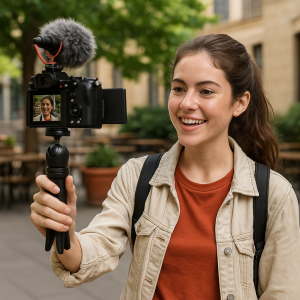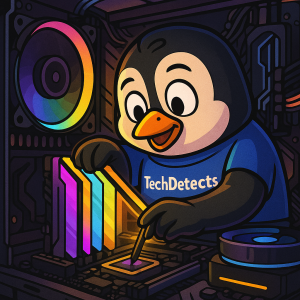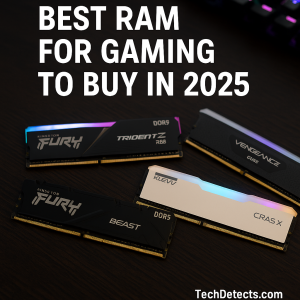Best Vlogging Cameras to Buy in 2025 – All Budget Ranges
Vlogging has evolved from a niche hobby to a full‑time profession for countless creators. Whether you’re documenting travel, creating tutorials, or building a lifestyle channel, the right camera determines how your story looks and feels.
In 2025, vlogging cameras range from compact pocket devices with built‑in stabilization to professional hybrid systems capable of cinematic 4K and 6K video. This expert guide highlights the best models available globally across entry‑level, mid‑range, and professional categories, focusing on ease of use, autofocus reliability, image quality, audio performance, and portability.

Quick Picks (TL;DR)
- Best budget compact: Sony ZV‑1 II
- Best under $1,000 hybrid: Canon EOS R50
- Best mid‑range mirrorless: Sony ZV‑E10 II
- Best pro hybrid: Panasonic Lumix S5 II
- Best all‑in‑one travel vlogging camera: DJI Osmo Pocket 3
- Best high‑end 4K cinematic vlog setup: Sony ZV‑E1
- Best action & outdoor camera: GoPro Hero 12 Black
🔹 Budget Vlogging Cameras (Under ~$700)
Sony ZV‑1 II
Why it’s great: Built specifically for vloggers, this compact camera delivers excellent autofocus, background defocus, and a wide 18‑50mm equivalent lens for handheld shooting. The flip screen, directional mic, and built‑in ND filter make it ready to record anywhere.
Best for: Beginners or travelers who want pro‑looking video without handling interchangeable lenses.
Specs: 1‑inch 20.1MP sensor · 4K30 · Real‑time Eye AF · 3‑mic array · USB streaming.
DJI Osmo Pocket 3
Why it’s great: The smallest true vlogging camera in 2025. Its 1‑inch CMOS sensor, 3‑axis gimbal stabilization, and 4K120 slow‑motion capability make it ideal for creators needing stabilized footage without extra gear.
Best for: Daily vloggers, travelers, and TikTok/Reel creators who prioritize smooth stabilized video.
Specs: 1‑inch CMOS · 4K120 · 3‑axis gimbal · large touchscreen · pocket‑sized.
GoPro Hero 12 Black
Why it’s great: The go‑anywhere, do‑anything camera. Excellent stabilization (HyperSmooth 6.0), waterproofing, and now improved color profiles make it perfect for adventure or sports vlogging.
Best for: Outdoor, sports, and travel vloggers needing durability.
Specs: 5.3K60 · 4K120 · 10‑bit color · waterproof to 10m · HDR video.
🔹 Mid‑Range Vlogging Cameras (~$700–$1,500)
Canon EOS R50
Why it’s great: Compact APS‑C mirrorless camera designed for content creators. The Dual Pixel CMOS AF II is incredibly fast, and it offers oversampled 4K30 with no crop. Fully articulating screen and easy face‑tracking make it a reliable mid‑tier choice.
Best for: YouTubers and hybrid shooters wanting Canon’s color science and ease of use.
Specs: 24.2MP APS‑C · 4K30 (no crop) · Dual Pixel AF II · RF mount · flip screen.
Sony ZV‑E10 II
Why it’s great: The next evolution of Sony’s top APS‑C vlogging camera, offering 4K60, improved 10‑bit color, and advanced autofocus inherited from higher‑end Alphas. Interchangeable E‑mount lenses allow creative flexibility while staying lightweight.
Best for: Creators stepping up from compact cameras to a mirrorless ecosystem.
Specs: 26MP APS‑C BSI sensor · 4K60 10‑bit · Real‑time tracking AF · E‑mount.
Panasonic Lumix G100D
Why it’s great: Lightweight Micro Four Thirds camera tuned for vloggers, now featuring improved stabilization and audio pickup. The OZO Audio system captures directional sound without external mics.
Best for: Budget‑minded vloggers seeking a balance of size, quality, and features.
Specs: 20.3MP MFT · 4K30 · 5‑axis hybrid IS · articulating screen · USB‑C charging.
🔹 Professional & Hybrid Vlogging Cameras ($1,500+)
Panasonic Lumix S5 II
Why it’s great: Full‑frame hybrid camera offering 6K recording, phase‑detect AF, and strong stabilization. Compact for its class, it’s ideal for pro vloggers and filmmakers who want cinematic quality without bulky rigs.
Best for: Hybrid shooters balancing YouTube content and cinematic production.
Specs: 24.2MP full‑frame · 6K30 / 4K60 10‑bit · Phase‑Hybrid AF · dual SD slots · L‑Mount.
Sony ZV‑E1
Why it’s great: Sony’s premium full‑frame vlogging camera with a 12MP sensor optimized for 4K and low light. Features subject framing AI, cinematic Vlog mode, and advanced audio options. Compact yet incredibly powerful.
Best for: Professional vloggers or creators who demand top-tier image quality with mobility.
Specs: 12.1MP full‑frame · 4K120 · AI subject recognition · in-body stabilization.
Canon EOS R6 Mark II
Why it’s great: Canon’s professional hybrid camera offering beautiful color, fast autofocus, and 6K RAW external recording. Excellent for those mixing vlogging, client work, and photography.
Best for: Creators who want versatility between pro video and stills.
Specs: 24.2MP full‑frame · 4K60 oversampled · Dual Pixel AF II · IBIS · RF mount.
🔹 Specialized Options
Fujifilm X‑S20
Why it’s great: The ultimate hybrid APS‑C vlogging option from Fujifilm. Features 6.2K open‑gate video, subject detection AF, and Film Simulation modes for instant color grading. Lightweight but feature‑packed.
Best for: Aesthetic‑driven creators and those who prefer Fujifilm’s distinctive look.
Specs: 26.1MP BSI sensor · 6.2K30 · IBIS · flip screen · USB‑C PD.
Insta360 Ace Pro
Why it’s great: Co‑engineered with Leica, this action camera combines AI features with a large 1/1.3‑inch sensor, capturing crisp stabilized 4K120 video. It’s a fresh alternative to GoPro for creators wanting smooth cinematic visuals.
Best for: Action vloggers, travel, and fast content creation.
Specs: 1/1.3‑inch sensor · 4K120 HDR · AI tracking · waterproof.
Comparison Table (At a Glance)
| Camera | Sensor | Video | Stabilization | Screen | Weight | Type |
|---|---|---|---|---|---|---|
| Sony ZV‑1 II | 1‑inch 20MP | 4K30 | Digital + OIS | Flip | ~292g | Compact |
| DJI Osmo Pocket 3 | 1‑inch | 4K120 | 3‑axis gimbal | Touch | ~179g | Pocket gimbal |
| GoPro Hero 12 | 1/1.9‑inch | 5.3K60 | HyperSmooth 6.0 | Front + Rear | ~154g | Action |
| Canon R50 | APS‑C 24MP | 4K30 (no crop) | Digital IS | Flip | ~375g | Mirrorless |
| Sony ZV‑E10 II | APS‑C 26MP | 4K60 10‑bit | IBIS + E‑Mount IS | Flip | ~360g | Mirrorless |
| Panasonic G100D | MFT 20MP | 4K30 | Hybrid 5‑axis | Flip | ~345g | Mirrorless |
| Panasonic S5 II | Full‑Frame 24MP | 6K30 | 5‑axis IBIS | Flip | ~740g | Mirrorless |
| Sony ZV‑E1 | Full‑Frame 12MP | 4K120 | 5‑axis IBIS | Flip | ~483g | Mirrorless |
| Canon R6 II | Full‑Frame 24MP | 4K60 | 5‑axis IBIS | Flip | ~680g | Mirrorless |
| Fujifilm X‑S20 | APS‑C 26MP | 6.2K30 | 5‑axis IBIS | Flip | ~491g | Mirrorless |
| Insta360 Ace Pro | 1/1.3‑inch | 4K120 | FlowState | Front + Rear | ~180g | Action |
What to Consider Before Buying
- Autofocus: Real‑time eye/subject tracking is crucial—Sony and Canon currently lead.
- Stabilization: IBIS or gimbal integration makes handheld footage smoother.
- Audio: Look for cameras with directional mics, mic inputs, or built‑in advanced audio systems.
- Flip Screen: Fully articulating screens simplify framing yourself.
- Connectivity: Wi‑Fi, Bluetooth, and webcam streaming capability are now essential.
- Battery Life: Always consider backup batteries or USB‑C PD support for long recording sessions.
Final Thoughts
The best vlogging camera depends on your workflow and style. Beginners should start with Sony ZV‑1 II or Canon R50, which provide professional quality without complexity. For hybrid creators, Panasonic S5 II and Sony ZV‑E1deliver cinematic results in compact bodies. And for creators on the move, DJI Osmo Pocket 3 and GoPro Hero 12 Black remain unbeatable travel companions.
No matter your budget, 2025 offers a vlogging camera tailored to your creative goals—just pair it with good lighting and sound, and your content will shine.





